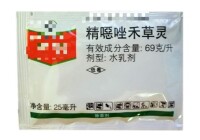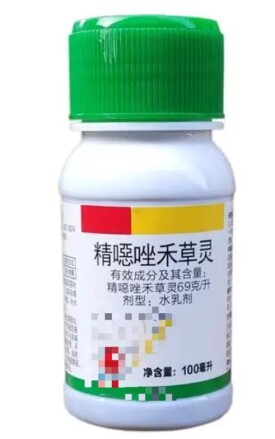適於雙子葉作物如大豆、花生、油菜、棉花、甜菜、亞麻、馬鈴薯、蔬菜田及桑果園等田中防除單子葉雜草。加入安全劑Hoe070542后適於小麥田防除禾本科雜草。
英文通用名 fenoxaprop-P-ethyl
其他名稱 驃馬,威霸,維利,高惡唑禾草靈,Hoe-046360,Hoe-33171,whip
毒性 屬低毒除草劑。原葯大鼠急性經口LD503040毫克/公斤,大鼠急性吸入LC50>0.604克/m3(4小時)。原葯對
兔眼和皮膚無刺激作用,對水生生物毒性中等,
虹鱒魚LC50(96小時)1.3毫克/升,對鳥類低毒。
劑型 6.9%
水乳劑,12%、7.5%、10%乳油。

惡唑禾草靈結構
屬雜環氧基苯氧基丙酸類除草劑,主要是通過抑制脂肪酸合成的關鍵酶一乙醯輔酶A羧化酶,從而抑制了脂肪酸的合成。藥劑通過莖葉吸收傳導至分生組織及根的生長點,作用迅速,施藥后2-3天停止生長,5-6天心葉失綠變紫色,
分生組織變褐色,葉片逐漸枯死,是選擇性極強的莖葉處理劑。
1.小麥田 防
禾本科雜草,
春小麥3葉期至拔節前,10%乳油450-600毫升/公頃,加水300L莖葉處理。
2.大豆田 大豆芽后2-3複葉期,52-69克/公頃 (有效成分),加水300-450L,莖葉處理。
3.花生田 花生2-3葉期,雜草3-5葉期,46.6-62 克/公頃 (有效成分),加水300L莖葉處理。
4. 油菜田 油菜3-6葉期,雜草3-葉期施藥,用量為41.4-51.75 克/公頃(
冬油菜),51.75-62.1 克/公頃 (春油菜),對水300L噴霧。
1.勿使藥劑流入池塘。
2.在單雙子葉雜草混生地可與
異丙隆,溴苯晴等除草劑混用。
| Chemical Abstracts name ethyl ( R)-2-[4-[(6-chloro-2-benzoxazolyl)oxy]phenoxy]propanoate CAS RN [71283–80–2] Development codes Hoe 046360 (Hoechst); AE F046360 (AgrEvo) Smiles code CCOC(=O)[C@@H](C)Oc1ccc(Oc2nc3ccc(Cl)cc3o2)cc1;without stereochemistry:CCOC(=O)C(C)Oc1ccc(Oc2nc3ccc(Cl)cc3o2)cc1 |
| Common name fenoxaprop-P (BSI, E-ISO); fénoxaprop-P (( m) F-ISO) |
| IUPAC name ( R)-2-[4-(6-chloro-1,3-benzoxazol-2-yloxy)phenoxy]propionic acid; ( R)-2-[4-(6-chlorobenzoxazol-2-yloxy)phenoxy]propionic acid |
| Chemical Abstracts name ( R)-2-[4-[(6-chloro-2-benzoxazolyl)oxy]phenoxy]propanoic acid CAS RN [113158–40–0] Development codes Hoe 088406 (Hoechst); AE F088406 (AgrEvo) |
| Mol. wt. 361.8 M.f. CHClNO Form White, odourless solid. M.p. 89–91 °C V.p. 5.3 × 10 mPa (20 °C) K logP = 4.58 Henry 2.74 × 10 Pa m mol (calc.) S.g./density 1.3 (20 °C) Solubility In water 0.7 mg/l (pH 5.8, 20 °C). In acetone, toluene and ethyl acetate >200, methanol 43 (all in g/l, 20 °C). Stability Fenoxaprop-P-ethyl is stable for 90 d at 50 °C. Not sensitive to light. Hydrolysis DT 2.8 d (pH 4), 19.2 d (pH 5), 23.2 d (pH 7), 0.6 d (pH 9) (25 °C) ( EFSA Sci. Rep. (2007) 121, 1–76). |
| Mol. wt. 333.7 M.f. CHClNO Form Light beige, weakly pungent, fine powder. M.p. 155–161 °C V.p. 3.5 × 10 mPa K logP = 1.83–0.24 (pH 5–9) Henry 1.91 × 10 Pa m mol(pH 7.0, calc.) S.g./density c. 1.5 (20 °C) Solubility In water 0.27 (pH 5.1), 61 (pH 7.0) (both in g/l, 20 °C). In acetone 80, toluene 0.5, ethyl acetate 36, methanol 34 (all in g/l, 20 °C). |
| History The herbicidal enantiomer of fenoxaprop was reported by H. P. Huff et al. ( Proc. Br. Crop Prot. Conf. - Weeds, 1989, 2, 717). Introduced by Hoechst AG (now Bayer AG) in 1988. |
| Manufacturers Bayer CropScience; Anhui Huaxing; Cheminova; Fengle; JIE; Jingma; Kajo; Sharda; Sundat; Tide; Zhejiang Hisun |
| Biochemistry Fatty acid synthesis inhibition in grasses, by inhibition of acetyl CoA carboxylase (ACCase). Rapidly hydrolysed in plants to the acid, which is still herbicidally active. Mode of action Fenoxaprop-P-ethyl is a selective herbicide with contact and systemic action, absorbed principally by the leaves, with translocation both acropetally and basipetally to the roots or rhizomes. |
| Uses Post-emergence control of annual and perennial grass weeds in potatoes, beans, soya beans, beets, vegetables, peanuts, flax, oilseed rape and cotton; and (when applied with the herbicide safener mefenpyr-diethyl) annual and perennial grass weeds and wild oats in wheat, rye, triticale and, depending on ratio, in some varieties of barley. Applied at 40–90 g/ha in cereals (max. 83 g/ha in EU) and at 30–140 g/ha in broad-leaved crops. Phytotoxicity Non-phytotoxic to broad-leaved crops. |
| Formulation types EC; EW; SE. |
| Selected products 'Furore Super' (Bayer CropScience); 'Foxtrot' (Cheminova); 'Masaldo' (Crop Health); 'Sunfenoxa-P-Ethyl' (Sundat); mixtures 'Hussar' (+ iodosulfuron-methyl-sodium + mefenpyr-diethyl) (Bayer CropScience); 'Puma' (+ mefenpyr-diethyl) (Bayer CropScience); 'Puma Super' (+ mefenpyr-diethyl) (Bayer CropScience). Other products 'Acclaim Super' (Bayer CropScience); 'Bugle' (Bayer CropScience); 'Depon Super' (Bayer CropScience); 'Option II' (Bayer CropScience); 'Rumpas' (Bayer CropScience); 'Silverado' (Bayer CropScience); 'Starice' (Bayer CropScience); 'Triumph' (Bayer CropScience); 'Whip 360' (Bayer CropScience); 'Whip Super' (Bayer CropScience); 'Felmon' (Efthymiadis); 'Jupiter' (P I Industries); 'Orion' (Biostadt); 'Ralon' (Nufarm Deutschland); mixtures 'Baghera' (+ diclofop-methyl + mefenpyr-diethyl) (Bayer CropScience); 'Cheetah Super' (+ mefenpyr-diethyl) (Bayer CropScience); 'Cheyenne' (+ MCPA-2-ethylhexyl) (Bayer CropScience); 'Corniche' (+ diclofop-methyl + mefenpyr-diethyl) (Bayer CropScience); 'Dakota' (+ MCPA-2-ethylhexyl) (Bayer CropScience); 'Djinn' (+ isoproturon + mefenpyr-diethyl) (Bayer CropScience); 'Dopler' (+ diclofop-methyl + mefenpyr-diethyl) (Bayer CropScience); 'Horizon 2000' (+ fluazifop-P-butyl) (Bayer CropScience); 'Hussar OF' (+ iodosulfuron-methyl-sodium + mefenpyr-diethyl) (Bayer CropScience); 'Podium S' (+ clethodim) (Bayer CropScience); 'Preclaim' (+ pendimethalin) (Bayer CropScience); 'Proper energy' (+ mefenpyr-diethyl) (Bayer CropScience); 'Puma Extra' (+ isoproturon) (Bayer CropScience); 'Puma Power' (+ mefenpyr-diethyl) (Bayer CropScience); 'Puma S' (+ mefenpyr-diethyl) (Bayer CropScience); 'Puma X' (+ isoproturon) (Bayer CropScience); 'Ricestar' (+ isoxadifen-ethyl) (Bayer CropScience); 'Ricestar xtra' (+ ethoxysulfuron) (Bayer CropScience); 'Tigress Ultra' (+ diclofop-methyl) (Bayer CropScience); 'Tiller' (+ 2,4-D-2-ethylhexyl + MCPA-2-ethylhexyl) (Bayer CropScience); 'Tiller Gold' (+ ethoxysulfuron) (Bayer CropScience); 'Turbo' (+ ethoxysulfuron + isoxadifen-ethyl) (Bayer CropScience); 'Wildcat' (+ mefenpyr-diethyl) (Bayer CropScience); 'Zeus' (+ diclofop-methyl + mefenpyr-diethyl) (Bayer CropScience); 'Bledor' (+ diclofop-methyl + mefenpyr-diethyl) (Siapa); 'Fenuron Super-Set' (+ chlorotoluron) (Nufarm Deutschland); 'Fusion' (+ fluazifop-P-butyl) (Bayer CropScience, Syngenta); 'Ralon Super' (+ mefenpyr-diethyl) (Nufarm Deutschland). Discontinued products 'Silban' * (IPESA); mixtures 'Tigress' * (+ diclofop-methyl) (AgrEvo); 'Tiller' * (+ 2,4-D-isoctyl + MCPA-2-ethylhexyl) (AgrEvo); 'Twister' * (+ fluazifop-P-butyl + fomesafen-sodium) (Syngenta). |
| Product analysis by hplc with uv detection; enantiomeric purity by chiral phase separation, followed by uv detection ( CIPAC Handbook, 2000, J, 51). Details are also available from Bayer CropScience. |
| TOXICOLOGICAL & ENVIRONMENTAL REVIEWS |
| EFSA Sci. Rep. (2007) 121, 1–76. 91/414/EC Annex I status Included, 2008/66/EC. |
| Oral Acute oral LD for rats 3150–4000, mice >5000 mg/kg. Skin and eye Acute percutaneous LD for rats >2000 mg/kg. Inhalation LC (4 h) for rats >1.224 mg/l air. NOEL (90 d) for rats 0.75 mg/kg b.w. daily (10 ppm), for mice 1.4 mg/kg b.w. daily (10 ppm), for dogs 15.9 mg/kg b.w. daily (400 ppm). ADI/RfD (EC) 0.01 mg/kg b.w. [2008]. |
| Birds Acute oral LD for bobwhite quail >2000 mg/kg. Fish LC (96 h) for bluegill sunfish 0.58, rainbow trout 0.46 mg/l. Daphnia LC (48 h) 0.56 (pH 8.0–8.4), 2.7 (pH 7.7–7.8) mg/l. Algae LC (72 h) for Scenedesmus subspicatus 0.51 mg/l. Bees LC (oral) >199 μg/bee; (contact) >200 μg/bee ( EFSA Sci. Rep.). Worms LC (14 d) for Eisenia foetida >1000 mg/kg soil. |
| Plants In plants, fenoxaprop-P-ethyl is metabolised via fenoxaprop-P to 6-chloro-2,3-dihydrobenzoxazol-2-one. Soil/Environment In soil, fenoxaprop-P-ethyl is rapidly hydrolysed to fenoxaprop-P (A. E. Smith, J. Agric. Food Chem., 1985, 33, 483); DT 1–10 d. |

